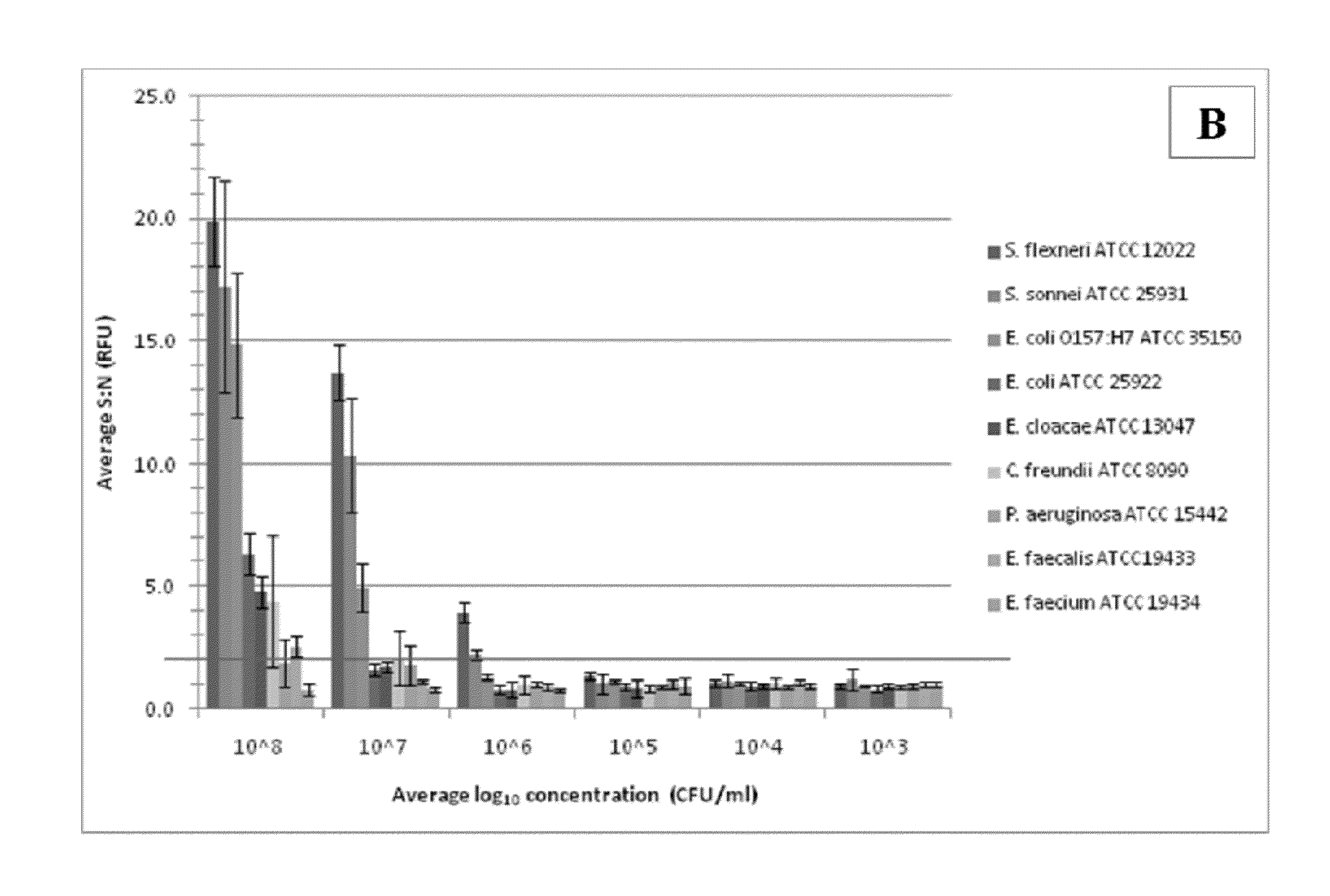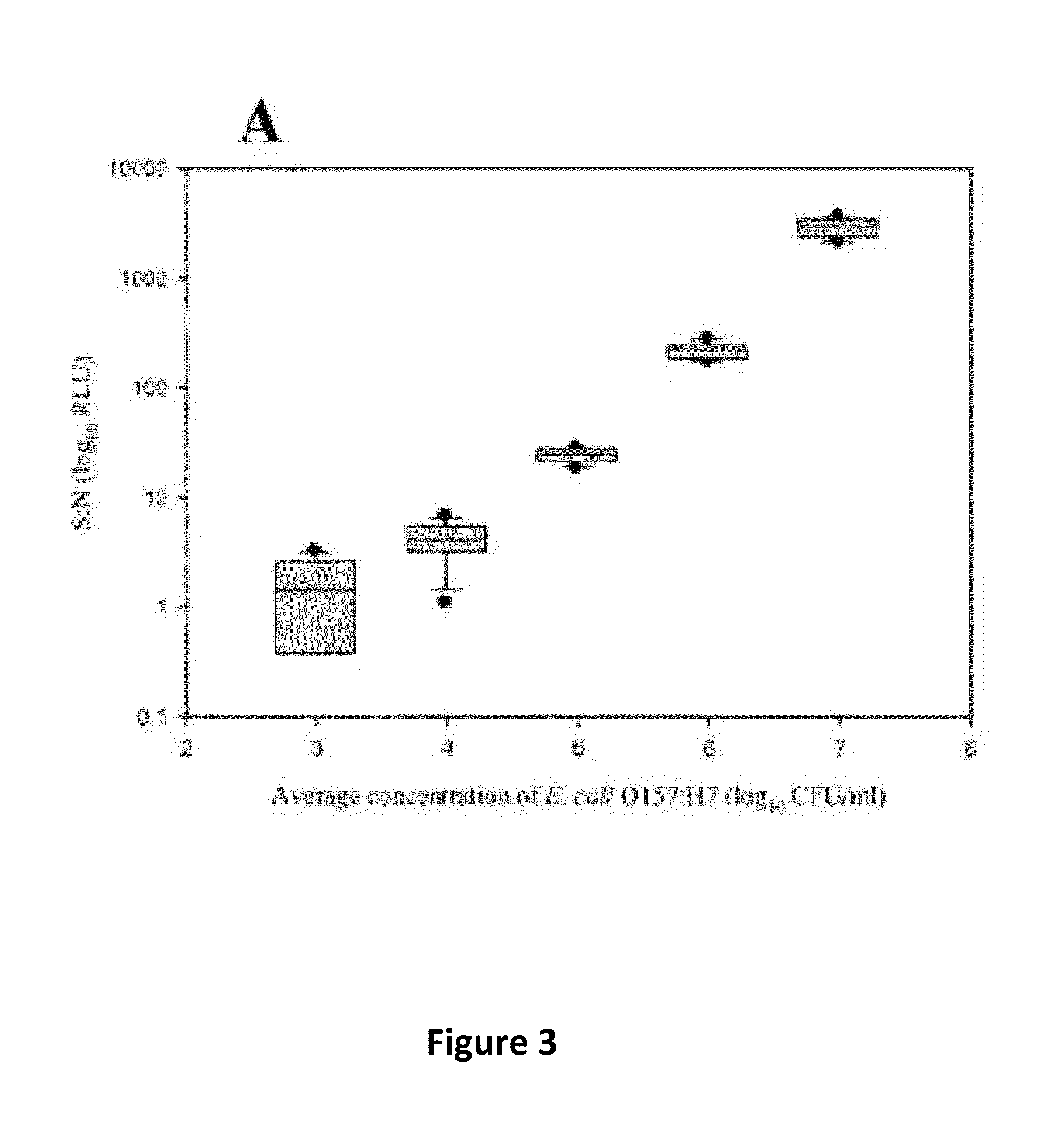ATP-bioluminescence immunoassay
a bioluminescence and immunoassay technology, applied in the field of atpbioluminescence immunoassay, can solve problems such as affecting capture efficiency, and achieve the effect of wide application and weak matrix
- Summary
- Abstract
- Description
- Claims
- Application Information
AI Technical Summary
Benefits of technology
Problems solved by technology
Method used
Image
Examples
example 1
Sample Analysis
[0047]Apple juice, milk, and ground beef were analyzed for the presence of viable organisms prior to inoculation. The apple juice and milk were free of contaminants. Analysis of the ground beef by the most probable-number (MPN) technique for total coliforms resulted in an average of 9.2 MPN / g. Additional analyses with CHROMagar O157 and API 20E tests strips revealed that the beef did not contain E. coli O157:H7 or Salmonella.
example ii
ELISA
[0048]The sensitivity and specificity of the Salmonella and E. coli antibodies were evaluated by ELISA. Positive detection (S:N≧2.0) of Salmonella Choleraesuis, one Salmonella Enteritidis, and six Salmonella Typhimurium strains occurred at 105 CFU / ml. There was also detection of four Salmonella Typhimurium strains at 106 CFU / ml; two strains of Salmonella Enteritidis at 106 CFU / ml and five strains at 107 CFU / ml; and Salmonella Hadar, Salmonella Kentucky, and two Salmonella Newport strains at 108 CFU / ml. Positive detection of all E. coli O157:H7 strains occurred at 105 CFU / ml. Both antibodies were nonreactive to the other organisms evaluated at all concentrations. Detection of the target strains was not affected by the presence of non-target cells.
example iii
ATP-BLIA
[0049]Immunocapture and detection of live E. coli O157:H7 in PBS, beef homogenate, and apple juice, and live Salmonella Typhimurium in beef homogenate, apple juice, and whole milk were demonstrated with ATP-BLIA. The LOD was determined by assessing significant differences in mean S:N≧3.0 RLU across concentrations for each matrix. Direct cell counts could not be completed prior to the assay, due to the background present in some samples, which resulted in assay-to-assay variability in cell concentration. The reported values are averages of total viable counts across all assays.
[0050]The LOD for E. coli O157:H7 in DPBS (n=12) was 9.68×103 CFU / ml for the target only (FIG. 3A) and 4.84×104 CFU / ml in mixed culture (FIG. 3B). There was no overlap of average S:N at concentrations >104 CFU / ml. There was also little variability within both sets of data for this matrix. S:N were significantly higher at all concentrations when comparing E. coli O157:H7 only to E. coli O157:H7 in mixed ...
PUM
 Login to View More
Login to View More Abstract
Description
Claims
Application Information
 Login to View More
Login to View More - R&D
- Intellectual Property
- Life Sciences
- Materials
- Tech Scout
- Unparalleled Data Quality
- Higher Quality Content
- 60% Fewer Hallucinations
Browse by: Latest US Patents, China's latest patents, Technical Efficacy Thesaurus, Application Domain, Technology Topic, Popular Technical Reports.
© 2025 PatSnap. All rights reserved.Legal|Privacy policy|Modern Slavery Act Transparency Statement|Sitemap|About US| Contact US: help@patsnap.com



